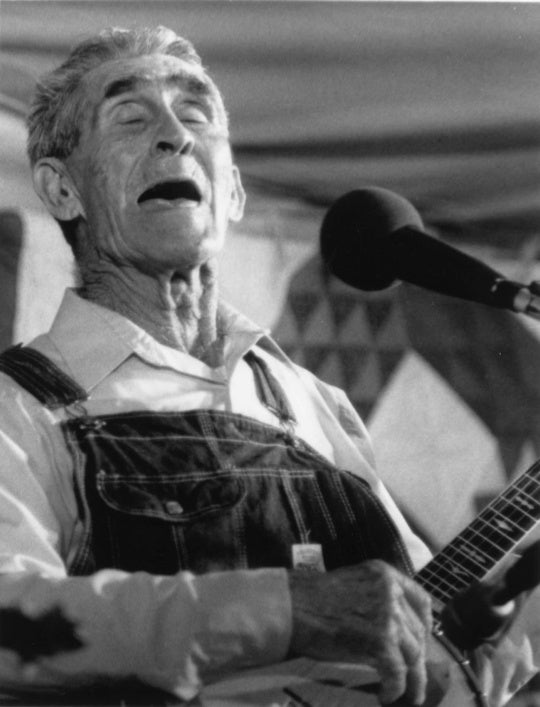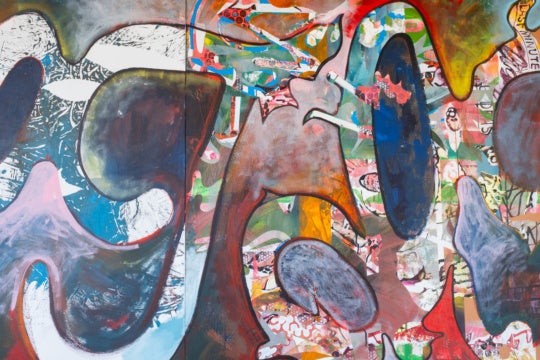
Knowing Who We Are is a massive reinstallation of the Ogden’s collection, bringing the museum’s permanent collection, founding donation, and recent acquisitions together into a 200-plus-year survey of art of the American South. Taking place across three floors, the exhibition is divided by period: The 19th to 20th century art -isms of American Impressionism, Social Realism, Regionalism cover the 3rd floor; Modernism on the 4th; and capital-C Contemporary Art on the 5th. It is an impressive exhibition, in scale and diversity of works and makers, foregrounding how Southern artists have and continue to engage with this place in all its forms, materials, and entities. Knowing Who We Are is a much needed contribution to the ongoing work of creating a more expansive historical record of Southern art.
Drawing its title from a Ralph Ellison quote, “knowing where we are has a lot to do with our knowing who we are,” the exhibition text states that it endeavors to “provide a portrait of place” that “shifts focus from antiquated stereotypes of region, period, style and subject to address a contemporary understanding of varied histories reflecting broader inclusivity and representation.” However, as I wove through galleries labeled with canonical classifications, I began to question how much of a challenge to the status quo the exhibition actually posed. Knowing seemed more like a telling in chronological order, abiding by existing art hierarchies of national/regional, high/low, have/have not.

Two artworks face one another across the chasm of the central staircase at the Ogden Museum of Southern Art: Crazy Quilt (2005) by Louisiana Bendolph of the Gee’s Bend quilters, and Drape Work (1970) by Sam Gilliam. Thread courses through the frenetic yellow quilt, reminding you that every inch of this cloth has been touched, held, as it hangs lonely on the wall rather than tucked on a bed. Draped, Gilliam’s colorfield canvas reveals itself as fabric, the conventional stretcher torn apart. Both works are heralded as modernist abstractions and charged by their material, but each marks the entrance to very different galleries— Vernacular Art and The Rise of Abstraction—presenting an immediate division in the narratives of 20th century Southern Art they each represent.

Curator Bradley Sumrall offers Vernacular Art as an umbrella under which the exhibited artists classified as “Outsider,” “Self-Taught,” and “Visionary,” can be placed for their aesthetic “common tongue.” These are contested terms, for which the wall text makes a cursory acknowledgement while still utilizing them as the skeleton of the exhibition.
Formally, within Vernacular Art, similarities can be found: most of the exhibited artists use everyday materials like rope, tin, manila folders, newspaper, and cardboard as the basis for their works. Thornton Dial’s Struggling Tiger in Hard Times (1991) is inches thick, as paint encases the titular leaping striped creature formed of rope and mounted on canvas and wood. Many are religious, such as Everlasting Gospel Ship (1968) by Sister Gertrude Morgan and World of the Happy and Free (1986) by Reverend Howard Finster. Both artworks portray scenes crowded with angels and saved souls, and both artists believed they were chosen by God to compose these works. Some are abstract, some figurative, some landscapes, some colorful and elaborate, others penciled black and white. Plantations, Mardi Gras Indians, Ruthie the Duck Lady, and the Laughing Cavalier all make appearances. It is a very broad range of vital artworks, though all informed by the very particular political economy of the South.
What the wall text shies away from is the main trend in who Vernacular/Outsider/Self-Taught/Visionary has historically defined— Southern artists who are Black and poor. Of the thirty-four artists in the Vernacular Art gallery, 28 are Black, and all lived within limited means. Many are descendants of enslaved persons, such as Clementine Hunter, Thornton Dial, and Louisiana Bendolph, who lived and created on that same land. We must be clear about the racism and economic oppression, restricting access to the formal credentials from which artists can derive market and institutional value, which have defined the circumstances for who is considered an “Outsider.”
Race and class are undeniably intertwined with how these terms are applied, and the lack of discussion of this fact feels like a polite, pointed absence. In the statement “On Language,” the Souls Grown Deep Foundation, which stewards a major collection of artworks by Black artists from the American South that includes almost all of the exhibited artists in Vernacular Art, declares:
The persistent reference to Black artists as “self-taught” emanates from a market-driven bias against artists of color….In light of the history and circumstances cited above, Souls Grown Deep abjures the application of the term “self-taught”—along with “outsider”, and “visionary”—to the artists from our collection.1

Why then are some institutions holding onto this tenuous and outdated terminology for dear life? Who do these terms serve other than those seeking to classify artists and artworks? Should we aim for a more expansive art history for ourselves that shirks ill-fitting language that does not respect the knowledge, skills, and practices of an entire community? How can we be challenging the past while continuing to utilize its essential structures? Maybe “Vernacular” is the way to go, without the others, as it cites a heritage of localized coding. Rather than referring to one’s proximity to authority or place within an arbitrary hierarchy, Vernacular centers visual articulation within and for a place.
On the flip side, after discussing all of this work supposedly made “outside of society” per the definition provided, The Rise of Abstraction opens with this: “The art of the American South has never existed in a vacuum.” The goal of the statement here, however, is to connect Southern abstraction with the New York School, presenting a network of Abstract Expressionism linked largely through academia. These painters are working bigger, many with oil and hold BFA/MFAs. The exhibition seems to prioritize these connections as a legitimizing force, even though it doesn’t need to be substantiated in this way— the exhibited artworks are strong enough. I wasn’t familiar with many of the artists, such as Robert O. Preusser and Dorothy Hood, so often overshadowed by the usual AbEx suspects, and walked through amazed.

Placed inconspicuously in between the two galleries, tucked beside the fire exit, is Turning Wheels (1984) by Moses Hogan a name familiar to anyone who has spent time singing in a gospel choir. Hogan, a lifelong New Orleanian and acclaimed composer most famous for his powerful choral arrangements of Black spirituals including “Elijah Rock” and “Swing Low, Sweet Chariot,” paints a surging spiral of fuschia sinking into a distant core of white light. It is the vision from “Ezekiel Saw De Wheel,” an allusion to the cosmogram, and a swirl of sound as voices crowd together on the risers. The wall label recognizes this gestural abstraction’s derivation from a syncretism of African American religion; if I were to pick a favorite wall label, this would be it. Abstraction is bigger than New York, than western Europe.
Rise of Abstraction’s text ends: “By including both 20th century and contemporary artists, academically trained and self-taught— this exhibition considers the legacy of Modernism in the American South.” The self-taught artists (lowercase this time) included in Rise of Abstraction, such as Minnie Evans, Clementine Hunter, and Clyde Connell, are all very well-known artists who have seen major museum limelight (Evans was included in the 2022 Venice Biennale). How has their prior prestigious institutional validation informed their placement into this “legacy of Modernism?”
One can argue that the inclusion of Vernacular Art within the museum is a positive act of uplifting— though, also arguably, while held at arm’s length. One may also note how the debate over this language is decades old; what can be gained at this point in continuing it? As Knowing Who We Are shows, defining identity is like trying to nail down a moving target, and hindsight isn’t always 20-20: I don’t know if there is ever a right answer for how to define someone else.
What I do know is that “The South” is a big place and hard to know, and I left Knowing Who We Are wondering how a taxonomy of Southern art serves the artists it classifies.
1 https://www.soulsgrowndeep.org/foundation/language. I learned of this statement from Samuel Reilly’s essay “What Happens When Vernacular Art Enters the Institution” for Art Review.
Knowing Who We Are is on view at the Ogden Museum of Southern Art in New Orleans, LA through March 3, 2024.




